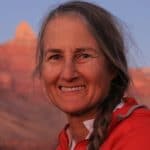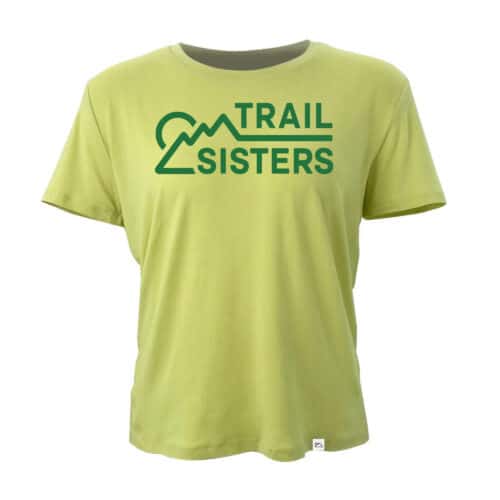I’m 58 and still learning what my feet have to tell me. And they’ve had a lot more to say since I stopped wearing shoes on the trail back in 2010.
Other people make comments, too: “Wow, that’s badass/hardcore/awesome/way to go!”
What younger-sister-to-a-beauty-queen doesn’t trot just a little quicker at that kind of muttered admiration by mountain biker guys half her age?
So, yeah, 58, and although I like to think I’ve been running for 40 years, with the last 22 trails only, too much of that is a blur of forced “rest” between all kinds of aches and pains—from neck to shoulder to lower back to piriformis to hamstring to knee to calf to ankle to arch to toe. Both Sides Now (cue Joni Mitchell).

Those fleeting times when I could run, though, were my magical (and legal) way to self-medicate for a life-angst that stretches back to at least age 14 (when my mode of self-medication was also magical but way less legal). Wouldn’t you know it, though—at age 15 a side effect happened: teen pregnancy. Yikes.
One husband and three kids and so many running issues later—and after way too many visits to the [medical doctor/physical therapist/chiropractor/rolfer/acupuncturist/movement coach]—there was one question from a PT pro (treating me for left knee pain after the 2004 Bishop High Sierra Ultra) that became a hot spot, if not downright blister, in my brain: “What is your injury trying to tell you?”
Back then, as a clueless but eager-to-learn 44-year-old, I figured there were only two answers: “listen to your body” and just give up, or “listen to your heart” and NEVER give up.
Then answer number three began its whisper: “Listen to your heart and body and keep running.”
So I bounced around between all those [previously listed] injury professionals, up to and including the custom-orthotic-prescribing podiatrist and the rooster-comb-injecting orthopedic surgeon, always searching for the magic treatment that would once and for all end my injured-runner blues.
And then I turned 50.
While attending a winter bird behavior workshop (yep, that’s a thing), I noticed some millennials warming themselves at the community fire wearing homemade-looking wool pants and nada on their feet. My initial mean-girl sarcastic thoughts transformed, once at home, into motivation for yet another rabbit hole exploration on the “what-the-heck” of barefoot hiking, then barefoot running.

Here’s some advice from a (almost completely) retired mean girl: There’s lot of mediocre-to-excellent books on barefoot running out there; purchase any one you like from your neighborhood independent bookstore, donate it immediately to your neighborhood library’s annual book sale, and just. Go. Barefoot.
When I did just that, I could not even tolerate the “hard” and “cold” and “unsupportive” floors in my own house. (Not unlike all the ex-boyfriends I never had because I got married when I was 16. Did I mention I was a teen mom? That was my only schtick till I discovered barefootedness. Now my schticks are multiplying at an alarming rate—my ridiculously long gray braid, sleeping without a pillow, and nose-breathing-while-running being a few more.)
It would be nice to end here with a cheerful “so yeah, just go barefoot and live happily ever after.” But that would be as simplistic as thinking there’s only two things your chronic running pains have to tell you.
My barefoot journey involved years of trail ambles at a glacial pace. Every time I’d begin to put together runs of 30, 45 minutes, the old left knee pain (or a new foot/ankle/back/neck issue) would spoil its way back into my life.
So all those years of slow involved lots more physical therapy of the myofascial release kind, as well as novel-but-miraculous movement coaching (Pilates, then Feldenkrais), all with the goal to be able to “trust” that stubborn left knee to not betray me miles away from the trailhead.
My excruciating left knee, unfortunate souvenir of the 2004 Bishop High Sierra Ultra (truth in storytelling: I was only running the 20-mile race that day). More than ten years later, my PT-du-jour asked if he could try something more from Eastern than Western medicine—he had me lie on my stomach while he attended to various pressure points on my back, all the while asking me to recount for him as many details of that day/race/incident as vividly and specifically as I could.
When I got to where the stabbing pain began (not far past the ten mile mark where the course headed back downhill to the Millpond finish line), Dr. Derrick had me imagine—with just the same level of realistic detail—finishing the race pain free.
Weirdly enough, this voodoo worked.
Now my research of trails began to lead into shadowy mind-body forests, where shapes began to appear: abandonment issues, boundary violations, bitterness, you name it—there was dark stuff hiding behind the physical aches and pains that I thought were “just” from running.
What to do?
Keep learning, journaling, praying, forgiving (others and myself)—and keep moving. A key turning point happened when I remembered one wise chiropractor’s words about the MRIs of my left knee and lower back, which each showed “some” damage that “might” be causing my symptoms, BUT (it’s a big but), but-but-but: he’d seen “lots of other people who had similar imaging results but no pain.”

Another light-bulb moment; psychosomatic is not a dirty word—it means you are not just a body or a mind, but a beautiful-inseparable combination.
Here are some authors who have helped me look at running pain—and life angst—in many new ways: Dr. Bessell Van Der Kolk, Dr. Peter Levine, Dr. John Sarno, Ruby Gibson . . . all light-bulb providers on my absurd (to anyone but another runner) life quest to. Just. Run.
***
Since age 16, I’ve been trying to stay married. And sane. That’s 42 years of wife-and-motherhood, and now my three kids are almost as old as I am. Maybe older, since it’s hard to imagine I’m not 30 any more, while my graying children range in age from 36-42.)
Sure, I sometimes feel pissy about all the stuff I missed staying home to be a homemaker/school volunteer/stage-and-soccer mom, but during the last eight shoeless years, it feels like I’ve got some of my childhood mojo back: I’ve crossed the Grand Canyon three times barefoot, a fourth time mostly barefoot (something about the abundance of scorpions on the trail near Phantom Ranch in the middle of the night freaked me out), and a fifth crossing last fall partly barefoot during an amazing six-day backpacking trip.

Then, in the last two years, my long-time ultra dreams came true: two partly barefoot 50k desert races–again following the philosophy “if it ain’t fun, put something on.” (The fact that the left knee pain returned in both these races only makes me more determined to keep listening to my body and learning to move in ways that lead away from pain.)
Did I mention my osteoporosis diagnosis, and the lower fibula stress fracture in 2016 (between the two ultras) that reduced me back down to barefoot limping on our lovely local trails?
Now what are you trying to tell me, wise-but-annoying mind/body?
That there’s always more learning to do, with metaphors everywhere: lower back pain from trying to carry too many work/family burdens; knee issues from reluctance to step forward into new ventures; brittle bones from holding on to bitterness . . . so much more psychosomatic voodoo that I would have laughed away as new agey wackiness at an earlier time in my life. Now: I am way more open (desperation much?) to new ideas.
Are you old and broken? Young and injured? Want to keep running forever? What could it hurt to think outside the orthopedic surgeon box? (Actually, it can hurt a lot to acknowledge trauma that you’d been distracted from all these years by those helpful injuries, so please seek mental health support as needed.)

Keep your Hokas on if you want; it’s not necessary to lose your shoes to gain insight into your mind/body connection, but you’ll be missing out on the fun of getting to know dirt, dust, mud, forest floor, rocks—so many kinds of rocky friends—and puddles! Creeks! It’s like being a kid again, only most of the angst is gone.
Q: What’s more fun than “just” barefoot trail running?
A: Getting to know the plants and critters that make their homes along your trails. Think about it: what’s the first thing you want to know when you meet a new running friend? “What’s your name?” So why not extend that politeness to the trees, wildflowers, birds, insects—talkin’ about you, Tarantula Hawk Wasp—you meet every time you head outside? Aim to pay attention to their sounds/smells/likes/dislikes/habits, and soon you’ll be surrounded not by vague “nature,” but actual companions who also have much to teach you.
So all I’ve learned has led to this: almost 60 years old, swishing through the dust with my big capable feet, my waist-length gray braid flopping away, greeting darkling beetles and towhees—even mountain bikers—with a smile, magically avoiding sharp rocks because I’ve been doing this for so long my subconscious places my feet for me, listening to my body—making adjustments—as I carouse for hours and hours on local-or-far-away trails, hoping others might be inspired to keep running so I can tell them, “That’s badass! Way to go!”















9 Responses
Way to go, mom!
Keep the dream alive. Can’t wait for the next adventure!
Thea, always enjoy your stories. Now you have to come South to run/hike/just hobble/ along barefoot!
Thanks, Flossie! This retirement gig has me hoppin’ . . . but . . . Next April the babysitting slows way down . . . Get ready for a visit 🙂
All that “Earthing” …connecting your body to the earth, helps to heal the mind, body and soul! Thank you for sharing, Thea : )
You’re welcome, Julia . . . it’s all connected . . . Happy (healing!) Trails, Thea
Amazing – you are such an inspiration Thea! Keep exploring!!
Thanks, Amie–I appreciate your comment 🙂
love your barefoot lifestyle. very healthy way to go
Thanks, Bill . . . it’s fun as well! Happy & healthy trails to you 🙂